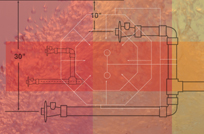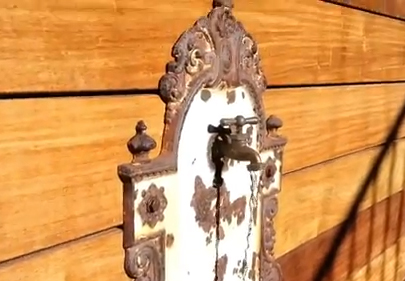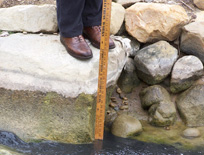water in transit
In many ways, installing a surge tank is simple. If you get it right, all will be well. As is the case with so many watershape systems, however, getting it wrong can lead to serious problems. Let’s start with some terminology. Surge tanks are receptacles used to accommodate the surge of displaced water in systems that can be generally defined as
Filling small courtyards and other compact spaces with the sounds of moving water is a valued service watershapers often perform for clients these days. A frequent approach in these cases involves installation of wall-mounted fountains in which water issues from a source set toward the top of the fixture and drops into a small basin from which the water is drawn and
Understanding how to move water from one level to another is among the most surprisingly complex challenges in all of watershaping. Indeed, there are lots of ways to get into trouble - even if you're confident that
With water-in-transit effects becoming more and more popular, increasing numbers of watershapers find themselves in need of external tanks to give these systems the surge capacity they need to function at peak efficiency. Here, Paolo Benedetti discusses his preferences when it comes to setting up his surge tanks – and defines a number of issues designers and builders should consider in making them both reliable and serviceable. As a rule, the surge tanks used in
As we discussed last month, perimeter-overflow details are among the most distinctive and challenging of all features in today’s custom pool market. In March’s column, we defined the different types of these edge designs, then described the complex, exacting process of building a knife-edge overflow system. This time, we’ll get into the hydraulic finesse needed to make these systems work. This includes everything from calculating bather surges to sizing the plumbing and surge tanks needed to make these effects function
When used to classify a design style, the term “modern” can carry many meanings. From the soaring, audacious forms of Frank Gehry and the sweeping organic spaces of John Lautner to the hard rectilinear shapes of Le Corbusier and the gem-like transparency of Mies van der Rohe, modernism is truly a broad conceptual umbrella. That sprawling diversity leaves designers and their clients with lots of wiggle room to get things done, but even so there can be challenges – as in the case depicted here, where the clients' desire for
The design and installation of the circulation, filtration and chemical-treatment systems for the pools at St. Lucia's Jade Mountain was a task of monumental proportions and extreme technical, physical and logistical difficulty. The effort was spearheaded by watershaper/hydraulics expert Chris Barnes, who spent months on site installing precision systems engineered to provide years of nearly maintenance-free service. Installing the circulation systems for the pools at Jade Mountain was a challenge unlike any other. I was first approached about the project by my good friend, Skip Phillips, who explained that he had already been working on the project's design for several years and indicated that it was going to be something truly amazing. He observed that the owner and his design team didn't have anyone in place with any experience with the installation of extremely complex watershapes and suggested that I might be the one to step up to the challenge and keep
From the grandest waterfall to the smallest courtyard fountain, water flowing over an edge is one of the most compelling of all watershaping “looks.” Whether it’s a vanishing edge or a slot overflow or a trough, runnel or waterfall, these effects all use one common concept – that is, the weir. Simply defined, a weir is a barrier or dam placed in a channel behind which fluid backs up and then falls through a notch and down the face of the weir. In most watershaping applications, water travels over the weir’s edge or brink and into some kind of lower basin, trough or pool. Physically and visually, these systems are driven by




















